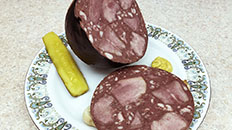Meats and Sausages
Morcilla de Lengua
Spanish version of a blood sausage made with tongue. Blood sausages made with tongue are characterized by large chunks of tongue and visible cubes of white fat in different sizes.
| Meats | Metric | US |
|---|---|---|
| Back fat | 300 g | 0.66 lb |
| Pork skins | 200 g | 0.44 lb |
| Pork tongue | 300 g | 0.66 lb |
| Blood | 200 ml | 0.44 lb |
Ingredients per 1000g (1 kg) of meat
| Salt | 20 g | 3.5 tsp |
| Cure #1 | 2.0 g | 1/3 tsp |
| Black pepper | 2.0 g | 1 tsp |
| Marjoram | 0.5 g | 1/4 tsp |
| Nutmeg | 0.5 g | 1/4 tsp |
| Cloves, ground | 0.5 g | 1/4 tsp |
Instructions
- Dice tongue into 15-20 mm (1/2-3/4") cubes. Mix with 1/3 salt and 1/3 cure#1 and place for 24 hours in refrigerator. The tongues will develop a nice red color.
- Cut/grind skins, cover with a little water and slow cook (below boiling point) until a gelatin paste is obtained.
- Dice partially frozen back fat into 6-8 mm (1/4-3/8") cubes. Place cubes n a strainer and scald them briefly with hot water, 90° C (194° F) what will remove any melted fat.
- Keep blood warm in a double pot (arrangement baño de Maria) or in a bowl immersed in warm water.
- In a warm bowl start mixing: tongue cubes, fat cubes, gelatin (skins), spices, and blood. The mixture must be warm otherwise the gelatin will prematurely harden.
- Stuff warm mixture into 80-120 mm beef cap end or pork blind caps (caecum).
- Cook in water first at 90° C (194° F) for 15 minutes, then at 80° C (176° F) for 60-90 minutes.
- Immerse the sausages in cold water for 30 minutes. Insert the sausage between two wooden boards, and place a heavy weight on top one. Hold for 24 hours at low temperature or in refrigerator. Then, cold smoke (optional step) for 6 hours.
- Store at 10° C (53° F) or refrigerate.


















